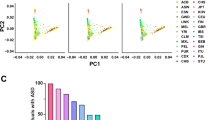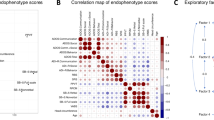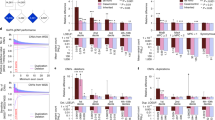Abstract
Autism spectrum disorders (ASDs) represent a group of childhood neurodevelopmental and neuropsychiatric disorders characterized by deficits in verbal communication, impairment of social interaction, and restricted and repetitive patterns of interests and behaviour. To identify common genetic risk factors underlying ASDs, here we present the results of genome-wide association studies on a cohort of 780 families (3,101 subjects) with affected children, and a second cohort of 1,204 affected subjects and 6,491 control subjects, all of whom were of European ancestry. Six single nucleotide polymorphisms between cadherin 10 (CDH10) and cadherin 9 (CDH9)—two genes encoding neuronal cell-adhesion molecules—revealed strong association signals, with the most significant SNP being rs4307059 (P = 3.4 × 10-8, odds ratio = 1.19). These signals were replicated in two independent cohorts, with combined P values ranging from 7.4 × 10-8 to 2.1 × 10-10. Our results implicate neuronal cell-adhesion molecules in the pathogenesis of ASDs, and represent, to our knowledge, the first demonstration of genome-wide significant association of common variants with susceptibility to ASDs.
This is a preview of subscription content, access via your institution
Access options
Subscribe to this journal
Receive 51 print issues and online access
$199.00 per year
only $3.90 per issue
Buy this article
- Purchase on SpringerLink
- Instant access to full article PDF
Prices may be subject to local taxes which are calculated during checkout


Similar content being viewed by others
References
Abrahams, B. S. & Geschwind, D. H. Advances in autism genetics: on the threshold of a new neurobiology. Nature Rev. Genet. 9, 341–355 (2008)
Autism and Developmental Disabilities Monitoring Network. 〈http://www.cdc.gov/mmwr/pdf/ss/ss5601.pdf〉 (2007)
Bailey, A. et al. Autism as a strongly genetic disorder: evidence from a British twin study. Psychol. Med. 25, 63–77 (1995)
Lauritsen, M. B., Pedersen, C. B. & Mortensen, P. B. Effects of familial risk factors and place of birth on the risk of autism: a nationwide register-based study. J. Child Psychol. Psychiatry 46, 963–971 (2005)
Sykes, N. H. & Lamb, J. A. Autism: the quest for the genes. Expert Rev. Mol. Med. 9, 1–15 (2007)
Gupta, A. R. & State, M. W. Recent advances in the genetics of autism. Biol. Psychiatry 61, 429–437 (2007)
Freitag, C. M. The genetics of autistic disorders and its clinical relevance: a review of the literature. Mol. Psychiatry 12, 2–22 (2007)
Veenstra-VanderWeele, J. & Cook, E. H. Molecular genetics of autism spectrum disorder. Mol. Psychiatry 9, 819–832 (2004)
Vorstman, J. A. S. et al. Identification of novel autism candidate regions through analysis of reported cytogenetic abnormalities associated with autism. Mol. Psychiatry 11, 18–28 (2006)
Sebat, J. et al. Strong association of de novo copy number mutations with autism. Science 316, 445–449 (2007)
Weiss, L. A. et al. Association between microdeletion and microduplication at 16p11.2 and autism. N. Engl. J. Med. 358, 667–675 (2008)
Kumar, R. A. et al. Recurrent 16p11.2 microdeletions in autism. Hum. Mol. Genet. 17, 628–638 (2008)
Marshall, C. R. et al. Structural variation of chromosomes in autism spectrum disorder. Am. J. Hum. Genet. 82, 477–488 (2008)
The Wellcome Trust Case Control Consortium. Genome-wide association study of 14,000 cases of seven common diseases and 3,000 shared controls. Nature 447, 661–678 (2007)
Sklar, P. et al. Whole-genome association study of bipolar disorder. Mol. Psychiatry 13, 558–569 (2008)
Alkelai, A. et al. The XVth world congress of psychiatric genetics, October 7–11, 2007: rapporteur summaries of oral presentations. Am. J. Med. Genet. B. Neuropsychiatr. Genet. 174B, 233–277 (2008)
O’Donovan, M. C. et al. Identification of loci associated with schizophrenia by genome-wide association and follow-up. Nature Genet. 40, 1053–1055 (2008)
Ferreira, M. A. et al. Collaborative genome-wide association analysis supports a role for ANK3 and CACNA1C in bipolar disorder. Nature Genet. 40, 1056–1058 (2008)
Geschwind, D. H. et al. The autism genetic resource exchange: a resource for the study of autism and related neuropsychiatric conditions. Am. J. Hum. Genet. 69, 463–466 (2001)
Lord, C., Rutter, M. & Le Couteur, A. Autism diagnostic interview-revised: a revised version of a diagnostic interview for caregivers of individuals with possible pervasive developmental disorders. J. Autism Dev. Disord. 24, 659–685 (1994)
Lord, C. et al. The autism diagnostic observation schedule-generic: a standard measure of social and communication deficits associated with the spectrum of autism. J. Autism Dev. Disord. 30, 205–223 (2000)
Martin, E. R., Monks, S. A., Warren, L. L. & Kaplan, N. L. A test for linkage and association in general pedigrees: the pedigree disequilibrium test. Am. J. Hum. Genet. 67, 146–154 (2000)
Chung, R. H., Morris, R. W., Zhang, L., Li, Y. J. & Martin, E. R. X-APL: an improved family-based test of association in the presence of linkage for the X chromosome. Am. J. Hum. Genet. 80, 59–68 (2007)
de Bakker, P. I. et al. Practical aspects of imputation-driven meta-analysis of genome-wide association studies. Hum. Mol. Genet. 17, R122–R128 (2008)
Wang, K. et al. PennCNV: an integrated hidden Markov model designed for high-resolution copy number variation detection in whole-genome SNP genotyping data. Genome Res. 17, 1665–1674 (2007)
Kuhn, R. M. et al. The UCSC genome browser database: update 2009. Nucleic Acids Res. 37, D755–D761 (2009)
Siepel, A. et al. Evolutionarily conserved elements in vertebrate, insect, worm, and yeast genomes. Genome Res. 15, 1034–1050 (2005)
Ovcharenko, I. et al. Evolution and functional classification of vertebrate gene deserts. Genome Res. 15, 137–145 (2005)
Abrahams, B. S. et al. Genome-wide analyses of human perisylvian cerebral cortical patterning. Proc. Natl Acad. Sci. USA 104, 17849–17854 (2007)
Kools, P., Vanhalst, K., Van den Eynde, E. & van Roy, F. The human cadherin-10 gene: complete coding sequence, predominant expression in the brain, and mapping on chromosome 5p13–14. FEBS Lett. 452, 328–334 (1999)
Visel, A., Thaller, C. & Eichele, G. GenePaint.org: an atlas of gene expression patterns in the mouse embryo. Nucleic Acids Res. 32, D552–D556 (2004)
Heinzen, E. L. et al. Tissue-specific genetic control of splicing: implications for the study of complex traits. PLoS Biol. 6, e1000001 (2008)
Witte, J. S. Multiple prostate cancer risk variants on 8q24. Nature Genet. 39, 579–580 (2007)
Ghoussaini, M. et al. Multiple loci with different cancer specificities within the 8q24 gene desert. J. Natl. Cancer Inst. 100, 962–966 (2008)
Kim, H. G. et al. Disruption of neurexin 1 associated with autism spectrum disorder. Am. J. Hum. Genet. 82, 199–207 (2008)
Szatmari, P. et al. Mapping autism risk loci using genetic linkage and chromosomal rearrangements. Nature Genet. 39, 319–328 (2007)
Arking, D. E. et al. A common genetic variant in the neurexin superfamily member CNTNAP2 increases familial risk of autism. Am. J. Hum. Genet. 82, 160–164 (2008)
Alarcon, M. et al. Linkage, association, and gene-expression analyses identify CNTNAP2 as an autism-susceptibility gene. Am. J. Hum. Genet. 82, 150–159 (2008)
Bakkaloglu, B. et al. Molecular cytogenetic analysis and resequencing of contactin associated protein-like 2 in autism spectrum disorders. Am. J. Hum. Genet. 82, 165–173 (2008)
Morrow, E. M. et al. Identifying autism loci and genes by tracing recent shared ancestry. Science 321, 218–223 (2008)
Redies, C. Cadherins in the central nervous system. Prog. Neurobiol. 61, 611–648 (2000)
Simes, R. J. An improved Bonferroni procedure for multiple tests of significance. Biometrika 73, 751–754 (1986)
Wang, K., Li, M. & Bucan, M. Pathway-based approaches for analysis of genomewide association studies. Am. J. Hum. Genet. 81, 1278–1283 (2007)
Just, M. A., Cherkassky, V. L., Keller, T. A. & Minshew, N. J. Cortical activation and synchronization during sentence comprehension in high-functioning autism: evidence of underconnectivity. Brain 127, 1811–1821 (2004)
Koshino, H. et al. fMRI investigation of working memory for faces in autism: visual coding and underconnectivity with frontal areas. Cereb. Cortex 18, 289–300 (2008)
Amaral, D. G., Schumann, C. M. & Nordahl, C. W. Neuroanatomy of autism. Trends Neurosci. 31, 137–145 (2008)
Courchesne, E. & Pierce, K. Why the frontal cortex in autism might be talking only to itself: local over-connectivity but long-distance disconnection. Curr. Opin. Neurobiol. 15, 225–230 (2005)
Hughes, J. R. Autism: the first firm finding = underconnectivity? Epilepsy Behav. 11, 20–24 (2007)
Frith, C. Is autism a disconnection disorder? Lancet Neurol. 3, 577 (2004)
Geschwind, D. H. & Levitt, P. Autism spectrum disorders: developmental disconnection syndromes. Curr. Opin. Neurobiol. 17, 103–111 (2007)
Ma, D. Q. et al. A genome-wide association study of autism reveals a common novel risk locus at 5p14.1. Ann. Hum. Genet. 10.1111/j.1469-1809.2008.00523.x (in the press)
Acknowledgements
We gratefully thank all the children with ASDs and their families at the participating study sites who were enrolled in this study and all the control subjects who donated blood samples to Children’s Hospital of Philadelphia (CHOP) for genetic research purposes. We also acknowledge the resources provided by the AGRE Consortium (D. H. Geschwind, M. Bucan, W. T. Brown, J. D. Buxbaum, R. M. Cantor, J. N. Constantino, T. C. Gilliam, C. M. Lajonchere, D. H. Ledbetter, C. Lese-Martin, J. Miller, S. F. Nelson, G. D. Schellenberg, C. A. Samango-Sprouse, S. Spence, M. State, R. E. Tanzi) and the participating families. AGRE is a program of Autism Speaks and is at present supported, in part, by grant 1U24MH081810 from the National Institute of Mental Health to C. M. Lajonchere (PI), and formerly by grant MH64547 to D. H. Geschwind (PI). We thank the technical staff at the Center for Applied Genomics at CHOP for producing the genotypes used for analyses, and the nursing, medical assistant and medical staff for their help with recruitment of patient and control subjects for the study. We thank R. Liu and I. Lindquist for helping with CNV validation. We thank D. J. Hedges, H. N. Cukier, J. L. McCauley, G. W. Beecham, H. H. Wright, R. K. Abramson, E. R. Martin and J. P. Hussman for their comments, advice and statistical support, and the laboratory core and the autism clinical personnel at the Miami Institute for Human Genomics and the autism clinical staff at the Vanderbilt Center for Human Genetics Research. A subset of the CAP participants was ascertained while M.A.P.-V. was a faculty member at Duke University. We thank the National Institutes of Health (NIH)-funded Developmental Brain and Tissue Bank at University of Maryland for access to the fetal brain tissues used in these studies (National Institute of Child Health and Human Development Contract no. NO1-HD-4-3368 and NO1-HD-4-3383). All genotyping of the AGRE and ACC cohort was supported by an Institutional Development Award to the Center for Applied Genomics (H.H.) at the Children’s Hospital of Philadelphia. The study was supported in part by a Research Award from the Margaret Q. Landenberger Foundation (H.H.), a Research Development Award from the Cotswold Foundation (H.H. and S.F.A.G), UL1-RR024134-03 (H.H.), an Alavi-Dabiri fellowship from Mental Retardation and Developmental Disability Research Center at CHOP (K.W.), the Beatrice and Stanley A. Seaver Foundation (J.D.B.), the Department of Veterans Affairs (G.D.S.), NIH grants HD055782-01 (J.Munson, A.E., O.K., G.D. and G.D.S.), MH0666730 (J.D.B.), MH061009 and NS049261 (J.S.S.), HD055751 (E.H.C.), MH69359, M01-RR00064 and the Utah Autism Foundation (H.C., J.Miller and W.M.M.), MH64547, MH081754 (D.H.G.), HD055784 (D.H.G. and M.S.), NS26630, NS36768, MH080647 and a gift from the Hussman Foundation (M.A.P.-V.), the Autism Genome Project Consortium (B.S.A., J.P., C.W.B., D.H.G., T.H.W., W.M.M., H.C., J.I.N., J.S.S., E.H.C., J.Munson, A.E., O.K., J.D.B., B.D. and G.D.S.) funded by Autism Speaks, the Medical Research Council (UK) and the Health Research Board (Ireland). We also acknowledge the partial support to CAP cohort from the Autism Genome Project.
Author Contributions H.H. and G.D.S. designed the study and H.H. supervised the genotyping, data analysis and interpretation. K.W., H.Z. and D.M. analysed the AGRE, ACC/CART and CAP data sets, respectively. K.W. drafted the manuscript, and H.H., G.D.S. and other authors edited the manuscript. M.B., J.T.G, M.I., J.P.B., P.M.A.S., C.E.K., C.H., E.F., R.C., C.M.L., R.M.C. and S.F.A.G. helped generate data and assisted with data analysis of the AGRE cohort. D.M., D.S., J.R.G. and M.L.C. generated data for the CAP replication cohort. B.S.A., L.I.S., A.I.A.R., E.I.H., H.D., T.H., M.S., S.O. and A.K. performed in situ hybridization, and generated data for the CART replication cohort. K.W., C.E.K. and E.R. performed qPCR validation of CNVs. N.T., T.S. and J.D.B. preformed MLPA validation of CNVs. J.Munson, A.E., O.K., J.P., T.O., J.A.S. C.W.B., R.B. J.R.G., W.M.M., J.Miller, M.W.S., T.H.W., H.C., S.E.L., R.T.S., J.I.N., J.L.H., J.S.S., E.H.C., N.J.M., J.D.B., G.D., D.H.G., M.A.P.-V. and G.D.S. collected samples, contributed phenotype data for the study, helped with interpretation of data, and assisted with manuscript preparation. D.H.G. and M.A.P.-V. contributed equally to this work.
Author information
Authors and Affiliations
Corresponding author
Additional information
The AGRE data set was genotyped by the Center for Applied Genomics at CHOP, and the complete sets of genotype and signal intensity data have been released to the public domain. AGRE-approved academic researchers can acquire the data sets from AGRE (http://www.agre.org). In addition, the summary statistics for the full data set will be made available in the repository of the NIH Genotype and Phenotype database (dbGAP; http://www.ncbi.nlm.nih.gov/projects/gap/cgi-bin/about.html).
Supplementary information
Supplementary Information
This file contains Supplementary Methods, Supplementary Tables 1-5, Supplementary Figures 1-7 with Legends and Supplementary References. (PDF 2213 kb)
PowerPoint slides
Rights and permissions
About this article
Cite this article
Wang, K., Zhang, H., Ma, D. et al. Common genetic variants on 5p14.1 associate with autism spectrum disorders. Nature 459, 528–533 (2009). https://doi.org/10.1038/nature07999
Received:
Accepted:
Published:
Issue Date:
DOI: https://doi.org/10.1038/nature07999
This article is cited by
-
A Spacetime Odyssey of Neural Progenitors to Generate Neuronal Diversity
Neuroscience Bulletin (2023)
-
The influence of NRXN1 on systemizing and the brain structure in healthy adults
Brain Imaging and Behavior (2022)
-
Serotonin-specific neurons differentiated from human iPSCs form distinct subtypes with synaptic protein assembly
Journal of Neural Transmission (2021)
-
Investigation of gene–environment interactions in relation to tic severity
Journal of Neural Transmission (2021)



